DWYCK: a Cipher on Hip Hop poetics Part 1
On December 12, an old creative ally passed away suddenly. A brilliant MC, a thoughtful poet, a visual artist, a jack all of trades, Zook aka Gadzook aka Zookness aka Craig Davis leaves with me a lot of good memories. I had hoped that Zook would get to read this post. To see someone over yonder shouting him out. Maybe if he read it Monday or Tuesday of last week that might have been the door swinging open. Maybe. Ain't that what it's all about? When we call out the names of those we desire communication with?
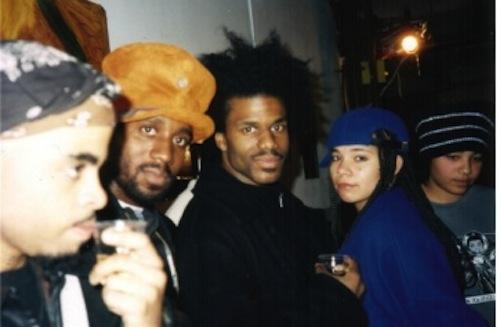
The last cipher I attended was in a place called ThoughtForms Underground whose equivalent might have been West Coast’s The Good Life, which in theory, was probably closer to Lyricist’s Lounge in the West Village. Regardless, ThoughtForms was a basement gallery-performance space on Franklin near Broadway in Tribeca created by Malik Yusef Cumbo, a young black photographer coming fresh out of the School of Visual Arts. ThoughtForms had become something of an incubator for young Black artists. Coming from Brooklyn, Harlem, Queens, New Jersey and elsewhere, the walls were filled with visual art, some of which would go on to be represented by larger galleries. On stage, a brew of rappers, poets, singers, dancers and musicians doing what they do. But the true cipher often took place in the hallway outside of the door of ThoughtsForms. A sort of spitting of minds amongst heads who were not featured acts but could still flex.
On another Franklin street, this time near Classon in Bed-Stuy Brooklyn, a small one-bedroom apartment hosted another cipher. I did not participate in the round robin of rhymes going on between Lord Jamar of Brand Nubians, a poet by the name of Zook, and some other cats whose names I fail to remember. Freestyle was definitely not my forte. What it did instruct me on was the atmosphere of improvisation, the mastery of vocabulary, the study of words, rhymes and knowledge (Five Percent Nation was in full effect). Yes, MCs came with their Roget's memorized. Some did not. And though the hostess, J-Me, who worked with Japanese composer Ryuichi Sakamoto, was definitely not an Earth to these Gods, she nonetheless gave folks a space —like ThoughtForms—to craft their skills and come together regardless of philosophical differences. The chessboard always ready for those who wanted to show off strategy. Might I add that J-Me, aside from cooking vegan meals from scratch, defeated the Gods countless times?
I am not a rap lyricist. That said the stylings and nuisances of rap lyrics find their way into what I do. So should my work be considered hip-hop poetry? Is the term more or less interested in the culture of hip-hop? Is it just a term that arose to market and benefit from what was already becoming a cash cow? Is the term just another manifestation of “urban poetry,” “street poetry,” and “ghetto poetry”: terms that might have “ghettoized” the poetries of my generation and those more recent?
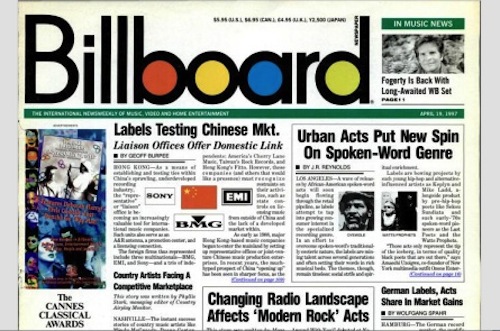
In the early 1990s, articles began to appear over whether or not hip-hop was poetry. As this gathering of lyricists, spoken word artists and poets influenced by hip-hop evolved and grew more popular, the strategy amongst music producers and promoters turned towards what should be the right label. Should these artists be in the Rap or Spoken Word Section of Tower Records? I never fully understood why it might be necessary to turn a spoken word artist with a hip-hop sensibility into a rapper OR a hard to define MC into a spoken word artist to attract college booking agents.
Then came publications like Saul Williams’s The Seventh Octave (1998), Listen Up! (1999), and Bumrush The Page (2001) which was originally intended to accompany HBO’s Russell Simmons’ Def Poetry Jam but somewhere down the line did not get the support). Soon followed Inner-Course: A Plea for Real Love (2003) by Toni Blackman (the first Hip Hop Cultural Envoy the US State Department) and Check The Rhyme: An Anthology of Female Poets and Emcees (2006), both of which highlighted women. A quick back track, Aloud: Voices from the Nuyorican Poets Café (1994) featured a handful of MCs and hip-hop inspired poets, of them included Reg. E. Gaines, Traci Morris, Michael C. Ladd, and Ninety 9, who worked with Prince and The Beastie Boys. Spoken Word Revolution: Slam, Hip Hop and the poetry of a new generation (2004) and Spoken World Revolution Redux (2007) each contain a chapter to officially declare and define what could be considered hip hop poetry. The term is officially given the stamp of approval so it appears.
2013. The University of Arizona introduces the nation’s first minor in Hip Hop studies at the same time Arizona bans Ethnic Studies. We should thank Vanilla Ice, Everlast, Eminem, Third Base, House of Pain and Young Black Teenagers for this, and of course Die Antwoord is taking it back to the Motherland. Stanford has a Hip-Hop archive. Harvard has a Hip-Hop archive. Hip Hop is forty soon to be 41 years old. Two definitive hip-hop poetry anthologies are on a race to be published first and I wonder who among their editors are the best chess players.
We begin our cipher. On the mic we have:
Kyle Austin aka High Priest aka HPrizm representing Queens.
Douglas Kearney aka Magellan aka Blot representing Altadena, Cali.
Patrick Rosal aka P-Ski of the Majestic Force Breaking Crew representing New Jersey.
Hanifah Walidah aka Sha-key representing Yonkers.
Yolanda Wisher aka Little Nay, Nay Nay and Pootsie, representing Philadelphia, PA.
LaTasha N. Nevada Diggs aka Squeaky representing Harlem, USA.
Rules to this cypher:
This is not 1993. Ladies and gentlemen, your sixteen bar answer (or 32 or 64 if we want to talk word count or not) is for you to drop. The mic will be passed to the left or not. No breaking the cipher. Fuck it. Break it. Traditionally, the cipher – consisting of a battle – would conjure the dozens as well as a healthy diss or two. For this cipher, we will try to keep the dissing to good old constructive debates. Critical analysis. Or not. No violence. No death threats. No raping of anyone’s momma, first born, or partners. No cultural stereotype mud slinging. No penis jokes or accusations of sleeping with sex workers during a writers conference (though it may very well be your purgative). They just happen to be attending a Crunk convention (or both) down the road in another Hilton. Let’s have some fun. Boo Yaa style!
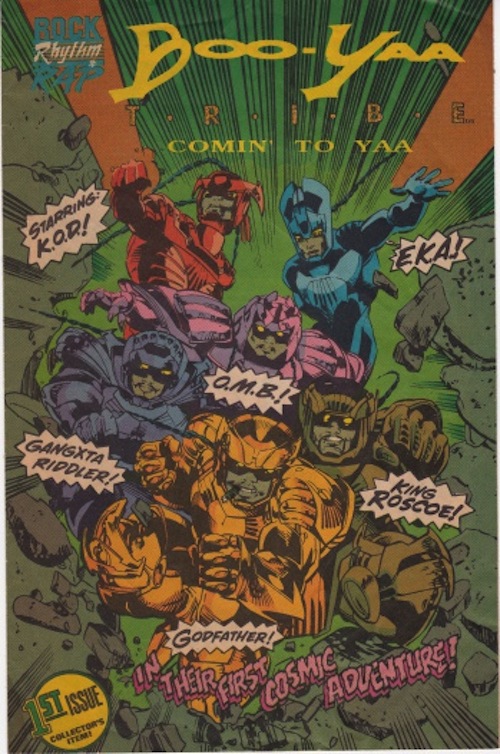
1. So off the jump, when was the first time you heard/read anyone make reference to the term “hip hop poetry” or “hip hop poetics”?
Patrick Rosal: I can’t remember when I first heard those terms, especially hip-hop poetics. I think they’re useful when I talk to folks who are interested in theory, but when I reminisce with friends from back in the day, those are not words that we would use. They came after the fact. I certainly didn’t hear those phrases or think of them when I was writing my first book in the mid-nineties through early zeros. I was writing from memory. As for a formal hip-hop poetics, I remember reading Mark Doty’s My Alexandria while in grad school and thinking to myself that he uses questions in his poems the way a DJ might cut away from a beat. Doty cuts away from declarative narration into interrogative reflection the way Mark Mendoza cut from Gaucho’s “Dance Forever” into the break from Antonia Rodriguez’s disco version of “La Bamba.” I had been using both linear sequencing (Roland MSQ-700) and non-linear/modular sequencing in the studio (Mark of the Unicorn’s Performer) since the late 80s and early nineties. And I thought to myself, a poem is like sequencing a good song: it has patterns and modules that repeat, break, and vary. But I couldn’t talk to anyone about that. No one in my MFA program had the same vocabulary. I was making up a metaphor as I went along just so that I could understand how poems worked.
http://www.youtube.com/watch?v=ShfvW8jar20
LaTasha N. Nevada Diggs: The first time I heard a reference to it was in the 90s regarding my work. I believe it was Bob Holman who introduced me as a Hip-Hop poet. I froze. I did not know what to make of it. I was frankly opposed to it. There’s an article that came out in The New Yorker in 1995 that Henry “Skip” Gates wrote about the rap and poetry scene in New York. It was called “Sudden Def.” In the article, Bob tells this story of when he met LL Cool J and upon telling LL that him rhyming “Ayatollah” with “Granola” made him Poet of the Year, LL responded that the word “poet” was financial poison. I don’t think my reaction had the same reason behind it. Rather, I felt it set me up, that now the audience was expecting me to rap. That’s definitely what I was first investigating in my earlier attempt at writing “poems.” The Q-Tip-isms were there. The Organized Konfusion-isms were there. A lot of struggle stuff. But rapper? Nah. No one I was hanging with was making these types of connections. They were just doing them. And the closest came around the time I was part of a collective called SOUP that was founded by Ninety-9. On the flyer she created she described us as “Jazz-oetry” and “Rap-oetry.” Again, not entirely the picture for me, but then again, the majority of the crew were MCs. What’s also fair to mention that Nine was part of a collective/term called “Boom Poetics” for which Hanifah (then Sha-key) was co-founder.
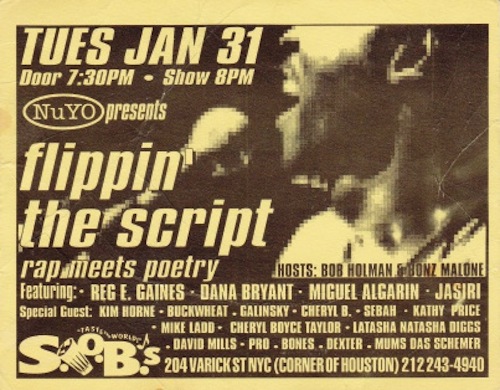
Back to this term. I later heard it on Pseudo.com, one of the first internet radio stations. They had a poetry segment called Go Poetry created by one of its founders, Robert Galinsky. Later with the released of Eargasms. This time it was “crucial poetics.” Oh, and flowetry before the group Floetry. But this term again. It confuses me some. I feel my process is organic and based on what I grew up hearing. Sure there is Hip-Hop. But there is also House music and a lot of Depeche Mode, Erasure, ABC, Siouxsie and the Banshees. If anything, my work has been a mash up of all these musical influences and dance elements. I also need to include Dancehall and I would never call myself a dub poet or toaster. Upon my entry into the spoken word scene in New York, I was still a cage dancer at The Palladium. So how I wrote then was also informed by how I contorted a half naked body in a cage and how I reassembled it when I was at an after hours club dancing to House music. My writing was also pretty weak. I need to point out here that I had the worst rhythm. Patrick, I got no love from the B-boys, B-girls, the Asymmetricals or the Grasshoppers. A quirky lonely freestyle. By the time I started working semi professionally in bands, how I saw rap lyrics was pretty much how I figured out how to keep on beat. I still had a lot of reading to do. For that moment, I knew I needed to refashion my ear in order to write. If that makes any sense.
http://www.youtube.com/watch?v=guzNJfunmkk
Douglas Kearney I have to admit, I love taxonomies. Maybe it’s the RPG geek in me. But at an aesthetic level, I find them useful in the same way I find any pattern of understanding useful; they give you something to disrupt as much as they give you a groove to lay in. That’s not to say that I’m not startled when someone lays a title on me without discussing it first. On that, I vibe with Diggs—emphasizing the tension around “what the audience expects versus what I plan to do.” Therefore the title interrupts my set list—I will have to explain how I see hip-hop informing my poetics, which I don’t mind doing, but I had organized my set without that bit! I’m pretty clear with folks about my sense that the notion of hip-hop poetics is the least interesting to me when it’s just rap on a page. So I really appreciate what P-Ski says about locating a turntablist technique at a syntactic/associative level. That’s what makes this stuff worth thinking about to me.
I couldn’t tell you the first time I heard the term, but I debated its implications with a friend of mine, Jahsun, back in 1997. We were talking about whether there was a difference between writing a poem (spoken word being our primary mode at the time) and writing a rhyme. For me, there was. Without question. And this seemed exactly as it should have been. I heard D.O.C. back in 1989 on “The Formula” when he slyly hid “rap” in his phrase “Rhythmic American Poetry”—but that was signifyin and also a gesture toward, legitimization, I guess. Diggs! I forgot that LL quote. Thanks!
http://www.youtube.com/watch?v=c-IJ9vbdNfA
High Priest: Unfortunately I am coming in on the tail end of the conversation but whatssup family. I first heard the term around the same time in early to mid nineties from the same people. For me it more marked a generational/ aesthetic thing more so than a particular style per se. Coming from a MC/Lyricist background I always tried to merge the two. The kinetics of “bars” with the literary merit was a particular aim. Gylan Kain and David Nelson were also big influences and so were Nas and KRS. All of them expanded the “canon” of poetry in my eyes.
http://www.youtube.com/watch?v=fRiitIqlcqY
During the mid-nineties, it was about being in company of great writers like Sapphire, Asha Bandele, Israel Tacuma, Jasiri Kafele, Roger Robinson, Malika Booker, Freestyle Fellowship, et al, along with my direct crews—Anti-Pop Consortium, BOOMPOETICS, VIBE KHAMELEONS, SOUP. The term for me was demarcating a period more so, than a particular style but I also remember a lot of heated conversations around the differences.
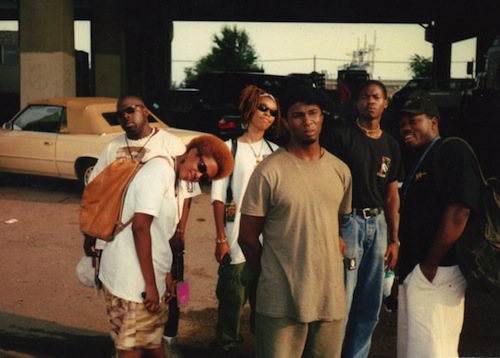
Douglas Kearney: Sup Priest!
High Priest: DK whattup!!
Hanifah Walidah: Hey people. Sorry for dropping in at the 11th hour. Ok.
Honestly, I don’t remember either, but I most likely laughed at it and let it exit stage left (ear). It’s redundant, simple and plain. The hyphenation (used or not) of art expressions, people, etc., suggests a hierarchy that gets under my skin for many reasons. But my first introduction to poetry was when I wrote a report in 4th grade about Langston Hughes. And that was also the same year Rappers Delight came out. Later KRS-1’s “Poetry” offered that hip-hop and poetry were synonymous. I think there is a difference between hip-hop poetry and hip-hop poetics. Hip Hop Poetry seems to me a fusion of hip-hop and prose performance and Hip Hop Poetics is an analysis of the poetics within Hip Hop. It’s all word play depending on what game your playing, I guess.
http://www.youtube.com/watch?v=8fSjmF9Ro8c
Douglas Kearney: Hello, Hanifah! “Hip Hop Poetics is an analysis of the poetics within Hip Hop.” I dig that. But I think when one actually makes that analysis and then applies it, the potential to do something other than “a fusion of hip hop and prose performance” exists. It doesn’t make one artist better than another, but I think it will often lead to something “different” and innovation (new styles) is, by definition, different. I suppose I prefer playing that game, but so what? Tradition is important and I don’t know the value (or the possibility) of completely abandoning it in the abstract. But pushing it seems important to me.
And, I want to make the point (and I’m not saying you said this at all) that analysis doesn’t mean writing a paper, doing surveys, whatever—but just critical thought, which happens in communities all over. I don’t want to overrate some kind of premeditation—that’s my habit—and innovation can come from just going out there and spitting. But I think if you hear someone spit, and then you say: “that was wack because____________. I’m not going to do it like that,” you are doing analysis, critically.
There are moments of raw inspiration that change the game (or invent it), but isn’t the game built on steadiness, a kind of consistency of style, technique. A tradition. Those who play the tradition “better” probably know something about the tradition. They’ve listened to it to better understand what they’re listening to, which is different than just consuming it. Because this listening is animated by an interest in “doing it.” Learning from it. Playing in it. You don’t have to go to a building called a school to do that. You can play guitar along with the radio. Memorize your favorite rapper’s lyrics and flow on a song. Watch your big sister pop lock and try to do it.
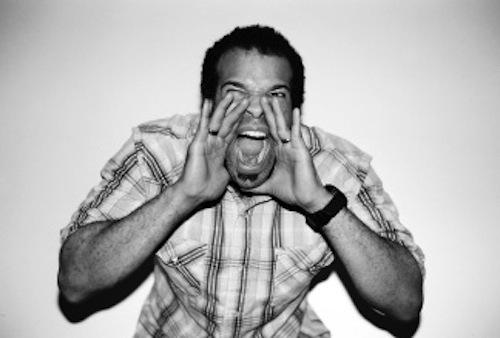
I consider all of these things modalities of analysis.
This doesn’t have to happen slowly. It happens in a freestyle battle—this MC said this to me, let me say that because I need that MC and the audience to know that I’m a better MC (for some: “I am always the better MC”; for some, “I am the better MC in this moment.”). This does not guarantee that MC will be better, but just to get to the battle, the MC is building on past battles, past losses; things that worked, things that didn’t.
But “better” requires an analysis and critical measure. If all you’re doing is talking, you’re not an MC (style judgment, analysis). You have to meet something recognizable as “rapping” (analysis and criticality). If you get to rep the community as an MC (or blues singer, or Gospel singer) you tend to be better at it (which may not mean technically so, but perceivably so). If you aren’t, you might still rap and sing, but you don’t occupy the space in the community as the one to whom we go for rapping and singing (or whatever). Is that not a critical indication that feels native to Black cultures?
Someone does a backspin. Then someone does a windmill. Then someone does a headspin. Maybe these things happened in vacuums. But the community witnesses and lets us know that a backspin is worth doing publically. And if that public likes the backspin, wait till they get a load of this windmill! If there’s no public, we don’t have anything to talk about in this cipher because even a cipher is more public than a lone writer/MC.

Yolanda Wisher: Coming in late in all, but here I go:
While I can’t remember the specifics, I think I first heard the term “hip hop poetry” in the mid-nineties. I remember seeing Sonia Sanchez and Rakim on the cover a literary magazine and a headline like “Rap is Poetry.” I think the term was also used when the Nuyorican Poets came to Lafayette College where I was an undergrad student. I believe it was used in reference to Tracie Morris’s work. I’m not big on labels, but I did hear a little Rakim and KRS in her voice, and I recognized some element of hip-hop music that lived in her approach to making word-music. I wanted to possess that talent and this tradition but I didn’t (yet) have the swagger and it wasn’t entirely my birthright considering the music I grew up on (Michael Jackson, Chaka Khan, Earth Wind & Fire, Tracy Chapman).
When I entered the poetry scene in Philadelphia in 1999 and began hosting readings, there were poets who clearly had a hip hop leaning or perspective and there were poets who did not. There were the people who dropped names and song titles in their poems and there were the people who were MCs in other hours and just came into the reading to share their work without accompaniment, sometimes so folks would really hear what they were saying. There were those who would involve freestyle in their performances—getting the audience involved to set the subject matter. A lot of them had a grip on crowd-control that other poets did not. Sometimes they were weak and wack but sometimes there were those folks who could make you think you were in the presence of someone who really understood the rhythm of words, the innate beats of language. And yes, these poets could be more commercial, versatile, and financial viable in the scene when it came to working in cafes/clubs and with musicians/bands and getting paid and getting gigs. Being able to rock the beat or freestyle was a prized ability that could set one apart.
This scene and the presence of these so-called or self-identified hip hop poets pushed my personal definition of poetry. It made me want to find a way for the hip-hop and hip hop ancestors I had grown up on to enter my poetry. It also re-prioritized hip-hop as a generational gem/phenomenon that as a writer—a black writer, and a musician, someone of this age/era—I had to reckon with. The changes and growth in hip-hop have given poets new avenues of expression, particular in performance. I dig the ways that poets steeped/raised/forged in hip hop have integrated or contested the aesthetics of hip hop into their writing, particularly in the ways Doug and Patrick described. More than any campaign that tries to validate hip-hop by calling it poetry, poets’ deep and respectful engagement with the history and elements of hip-hop is golden and innovative. Some part of me wants to say call it what you like as long as you’re really willing to get down into to the nitty-gritty of it and really bend/break the mediums of poetry and hip hop to get them talking intimately to each other.
LaTasha N. Nevada Diggs: And Yolanda drops the mic.
2. How do you define Hip Hop poetics? In the forward written by Sonia Sanchez for Bum Rush The Page, she connected Hip Hop poets to what she called the “bebopic beat,” a type of poetics that was invested in “the pace of sound, the swiftness of sound, the discordant way of looking at the world of sound, the blackness of sound, the beat of sound, etc.” That said, as my ear is often reaching for the performative quality (this of course is coming from where I come from), when we look at the works of Duriel E. Harris in Spoken Word Revolution: Redux, to the performance ear, it’s very slow to hear the sometimes obvious connections to like let’s say a Bahamadia or De la Soul. And perhaps, the poem “Cross Fader” by John Murillo is more obvious. Help me out with this one.
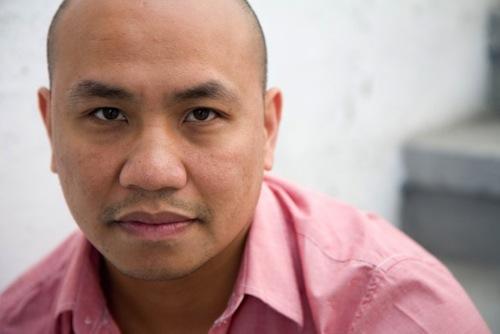
Patrick Rosal: I’m going to answer this by trying to define a remix poetics that is a descendant of hip hop and retains hip hop’s sense of the “God Self,” in Afrika Bambaataa’s words. A remix poetics is one that makes use of ordinary and everyday sound, music, and speech fragments that are normally ignored, undervalued, obscured, distorted or outright invisible in the dominant culture—particularly as an act of agency and survival—and makes sense of conflicting images, ideas, and feelings by juxtaposition. I love D Scott Miller’s Afrosurrealist manifesto, which revives the spirit of Aimé Césaire’s Negritude. We’ve often been separate and even at odds with one another: African Americans, Latino Americans, Asian Americans, Native Americans, Caribbean Americans…many groups who have been subjected to empire, capitalism, and patriarchy. What’s remarkable to me is the similarity in our response to various kinds of subjugation: we collage, to use the term coined late by the European traditions. We remix. We syncretize. Our individual and collective God Selves reside in the transition, the juncture, the break.
Douglas Kearney: I hear you. I wonder, though, is it on the level to associate hip-hop with “the use of ordinary and everyday sound, music, and speech fragments”—I know you are speaking more directly to remix culture, but is scratching an everyday sound? A wildstyle…an ordinary use of Rustoleum? “I start to think and then I sink into the paper as if I was ink. When I’m writing I’m trapped in between the line, I escape when I finish the rhyme” an everyday speech fragment? I’m probably just being particularly alert to questions of vernacular and an aesthetic that signifies the vernacular because of some research Tisa Bryant are doing on “Textual Orality.” I just want to emphasize that I am only asking about how we might define ordinary or everyday because someone deciding to airbrush his or her jeans jacket was not, at the point of creation, ordinary. That person did it to stand out! That to rhyme one’s talk was to stand out from “ordinary speech”—and that to not recognize this I think risks “naturalizing” hip-hop in the same way we naturalize athleticism. Such naturalization removes thought, discipline, aesthetics (as a code of values) from the equation. Attention to “practice” doesn’t mean hip-hop emerged fully formed from a think-tank (although we should pay attention to the fact that the rooms where people create hip-hop “artifacts” are often called “labs” (see Joseph Schloss)), but it did emerge culturally. It does take on names (many from within the cultural milieu) that we didn’t use before.
LaTasha N. Nevada Diggs: Patrick, it’s interesting that you brought up this word collage as I’ve been thinking a lot about the term pidgin. Some may see pidgin as a simplified form of communication but the more you dig deeper into the history of various pidgins, this means of communication is actually very complex. There is this “collage” of words, sounds, histories, natural forces that conjoined, create this new language. So in certain ways, I feel this has been taking place in hip-hop culture. You mention Bambaataa and I am immediately drawn to a story he once told about going downtown to hang on the punk scene and when Malcolm McLaren takes a trip to the Bronx and is introduced to what was becoming the elements of hip hop. I also think a lot about DJ Q Bert. I’m saying here that hip-hop is a pidgin in my head. The layering of exchange, the creation of more layers that ultimately complicates the language. Without headphones. Douglas, I get you on the risks of naturalizing what we hear in hip hop lyricism, but to play with you, the first individual who decided to use safety pins to tighten up and accentuate the lower half of their Lee’s indeed wanted to stand out but his/her decision was soon “bit.” It becomes part of the vocabulary. And for a short period it becomes absorbed and regenerated by that very community. Iron-on letters, hearts and zodiac signs, shoelaces and studded jackets got real normal.
http://www.youtube.com/watch?v=STCTCgQ3XJU
I just came across another term folks: def poetry. I'm soooo confused. Maybe it’s not as bad as 'Hallmark'?
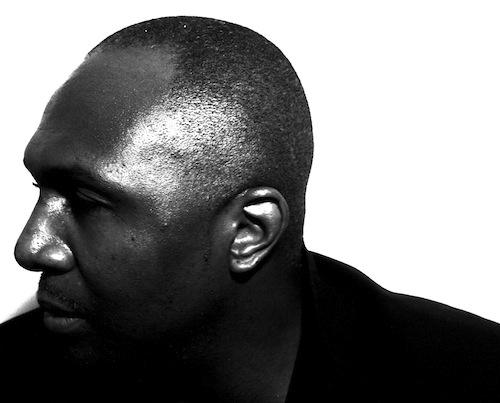
High Priest: I looked at it as poets raised with the syntax of hip-hop but at the inception of the phrase, battle lines were drawn. With rap and poetry's common ancestry in the Griot tradition…it's tricky. I love Patrick's reference to the God Self. My favorite writer's enliven their words with that energy.
Douglas Kearney: I dig what Priest is saying regarding syntax. When that kind of artfulness/artifice is the foundation, I feel like there’s something even more to build on. Something perhaps grounded in an “etymological” hip-hop. Especially if we take syntax to incorporate what happens when there’s a mondegreen, a phrase detourned and cut with a needle, aaaaaaannnnnnddddd the syntax of several tags on a single train, or even more trans/disciplinarily speaking, the syntactic shift of an original composition into a chopped and/or looped sample.
High Priest: To add on, with regards to syntax: Art forms reflect the “energy” of the times in an esoteric sense. Hip Hop, having strong links to Islamic/5% Nation culture (and direct corollaries to Griot culture) was a reflection of the cultural frequency of the time. Hip Hop Poetry is/was a by-product of those energies in my eyes.
Hanifah Walidah: For the sake of this cipher I will try to define Hip Hop Poetry as its understood here, in more so through a recent history of spoken word. When we speak of collages then we are speaking of an endless number of variations and definitions. History is part fact and part perspective but it is how I enjoy defining most things. Who were the who’s, what’s where’s and how the hell did this stuff come to be. Hip Hop Poetics, poetry or spoken word or slam poetry or whatever one wants to call it can find its aesthetic roots from young MCs who started to populate the Village in the early 90’s coming from the outer boroughs. Those of us raised in New York were still in shock if not in denial that the hip-hop industry was paying more attention to the West Coast. NYC felt a little like a ghost town as far as venues and industry support. The last actual hip-hop clubs were closing. Hip Hop Poetics was a result of this migration. It became a fusion of a hip-hop performance and rhythms and an immersion into the beatnik poetry (another kind of performance) scene that was already at home in the Village. It was a sincere discovery and exploration of artistic expression birthed in ambition and a glaring unknowingness. What the Village meant to my crew at the time (the Vibe Khameleons), was a stage (period). It was an opportunity to perform and find who we were as artists. Because we were young we were open, determined, arrogant, politicized and affected by the music around us, very similar to the black arts movement. Again history repeats itself. Hip Hop poetics (poetry) is one generation of artists fearless journey into maturity.
LaTasha N. Nevada Diggs: The erasure of venues supporting Hip Hop. That Hanifah, I can agree on since I worked and/or frequented several. The beatnik thing, I cannot. Many of the venues in Manhattan—Trip nights at Mars, The Tunnel, Palladium, MK, The Building, Payday, Soul Kitchen at S.O.B’s (ok it was more about rare grooves but it did attract a large hip hop demographic) and even Nell’s—all of which had a hip ho- night were catching the wrath of Giuliani. The communities from which these clubs were located never got comfortable with seeing this many colored folk in one area. And when the clubs shut down, I sincerely believe an alternative gathering evolved. That was Vibe Khameleons at ACME in the Village, Soup at the Blue Room in The Supper Club, Green Card Poets at Nuyorican, T’kalla’s crew up in Greenpoint above or below Bill Laswell’s loft. Washington Square Park. The Five Spot. Don Hills. What then emerged was The Lyricists Lounge at Wetlands and Thoughtforms where Speech Craft 101 and Avant Yard jumped off. What’s interesting is that the element of dancing returns with Thoughtforms and the Tea Party in Brooklyn. With the decline of venues for Hip-Hop, the House music venues were being shut down as well.
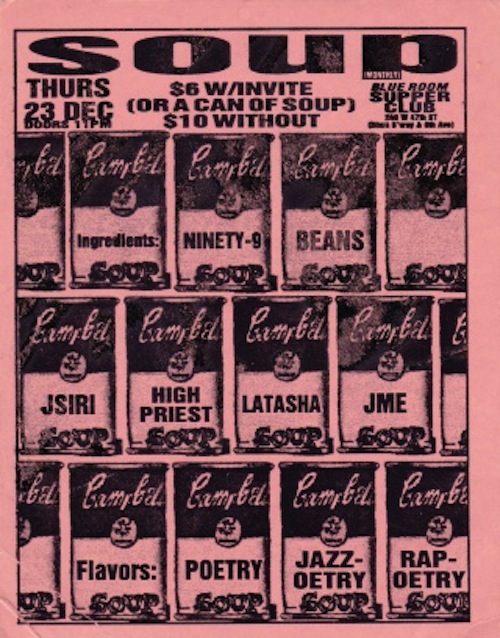
Yolanda Wisher: I like Patrick’s definition and all that collage and those seams and edges. I think hip-hop poetics has something to do with the beat and the drum and its power to gather and move. The ability to recreate the drum in language. And yeah, creating/biting vernacular to create a persona. A powerful self that rules the beat and the world. The self as drum.
3. Can you beat-box? Write a haiku? In previous writings that have attempted to define this form, there seems to be a prerequisite for hip-hop poetics that includes rapping, freestyle, and writing haiku. Is any of this valid? Or can a contemporary form of hip-hop poetics omit such tropes like the urban landscape, poverty, street culture, talking hype, or an actual beat and still be deemed coming from a hip-hop aesthetic? Can a hip-hop poetic omit any of the other five elements of hip-hop culture?
Douglas Kearney: I can’t beatbox worth a damn. At least I couldn’t until the Timbaland style beats became legit. My bass always sounded like a fart, but I can pull off a cut kick and the high-end percussion. I know I’ll catch flak, but for me, the hip hop poem that comes off as an a capella, typed up rap is the low hanging fruit. Like: of course a rap is a hip-hop poem! I’ve been interested in the procedures of the other elements and the dynamics of them to push my notion of a hip hop poetics. Like, if one is thinking of graffiti, should that poem be printed OVER another text? If one is thinking of sampling, should that be all cento? Is every quotation a “chop?” How does one transform a sonnet? Should a hip hop poem be a communal effort? These questions interest me.
http://www.youtube.com/watch?v=Od376QlXIaM
Hanifah Walidah: Chile please. Use to, but my skills have seriously waned.
This is a solid question. Well I think the performer has to decide what he/she includes in their work. The urban trope of talking shit, etc. comes again from a historical context and the conditions of the fore-practitioners of hip-hop, blues, jazz and so on. The individual expression has never and will never be restrained by a sort of culture created dogma in any art form. These individual expressions, these deconstructionists, these explorers expand the art form and then the theorists and critics call that person the father/mother of….Ok, I think I would like to take this opportunity to state what has been obvious to me as a woman who rhymes, sings and performs. This struggle between individual and the collective is a battle among men. Who is the b(est) or the great(est) rapper, jazz musician, blues artist…blah blah. The dogma of the 4, 5 elements is marketing pure and simple. An attempt to define ourselves before anyone else does. The only problem is it becomes dogma under the guise of some sort of sacred text or fact. So attitudes, poverty, music forms are so tightly intertwined and defined they move towards stagnation.
To then top this or to mold it into a statue we need to know who is "the best." What one person or style we should focus on this year, this generation? Even when hip-hop poets or MC’s collaborate it is a passing of the mic. It is always a one person on the mic at a time. I will find some exception with a handful of hip-hop poetry groups and their forefathers like the Last Poets. To this day the vast majority of poets work alone and hold the stage down by themselves. A feminist approach, however, is to see the collaborative possibilities of the endless variations of human creation. It is a knowing and desire to see what we can create without the temptation of solo ownership or title. For example, remember when Jill Scott and Erykah Badu essentially battled in Dave Chappelle’s Block Party. We all saw it go down on screen. We observed the MC/diva like confidence of Jill Scott and though equally competent, the initial awkwardness of Ms. Badu to go up ‘against’ Jill. But I also saw Badu make a decision to jump in though her voice is not as powerful as Scott’s is distinct. In the beginning you heard the voices battle one another but like magic the voices began to lock and create something bigger than and apart from them both. You couldn’t tell who was singing what. It was one of the more beautiful things I’ve seen on screen. But yet people to this day may compare the two as oppose to imagine what these two great women are when creating something together. Battles and freestyles are both fun and to a degree spiritual but it is not the end-all be-all of hip hop expression and its impressions on hip hop poetry.
Yolanda Wisher: I beatbox at home in private. I have never beatboxed in public and have no plans to do so. But I have read my poems alongside someone who was beatboxing, which I know doesn’t count. I think you gotta wrestle with these elements of hip-hop and decide what parts of the thing is where you’re coming from at any given point. Hip-hop is the thing itself but it’s also the packaging. Talking shit might be necessary for this book or that chapbook. Each track is an evolution. If I think of poems or poem texts as tracks that I’m about to drop, if I think of the spaces between poems as De La interludes and not just silences, I’m exploring a hip-hop poetic. I don’t know about the urban impoverished angle--you don’t have to have that perspective to be a rapper. But I do think there’s something core or key about struggle and hustle (that underdog saga) no matter where you’re coming from or who you think you are.
http://www.youtube.com/watch?v=foDUoSAtfsU
Patrick Rosal: What’s good, y’all. (Sorry, I stepped out the cipher to fix my rice cooker.) I think I’m like Yolanda. I beatbox, but never in my own set. I’m terrible at it, but I do it anyway, at home or if I catch a beat coming off a stoop as I’m walking by, just to vibe with it. But it’s like practicing chops. Trying to beatbox, as bad as I am at it, it makes me pay attention to the anatomy of a beat—the kick and hi-hat patterns, snare placements and dis-placements.
Douglas has mentioned tradition a couple times and there are burdens that tradition hands down. The word tradition, right?, comes from the Latin “to hand across.” It’s a way of history asserting itself in our work. There’s another word in the English language that means “to hand across”—treason. And so as artists we both inherit a tradition, but also, I think, we commit various treasons against it. And I don’t mean one tradition—but many traditions simultaneously. So, can we be unburdened of the traditions of hip-hop? Probably not entirely, but the very act of invention makes us complicit in some treason. (I’m suddenly thinking of the etymological associations of Kool Moe Dee and Spoonie Gee’s crew--the Treacherous Three.)
http://www.youtube.com/watch?v=Hk_DBrjtH0s
4. How does Hip Hop poetics relate to a blues or jazz poetics all of which remains centered around a form of music?
Patrick Rosal: My own poetics derives in part from traditional music theory—mostly as it relates to jazz but also the blues. The tritone, the blue note, that funky interval was, as we know, considered evil in traditional European music. It is the foundation for building blues-based jazz voicings. With very, very little movement of the fingers, you can build very rich textures on the guitar by constructing harmonies around those two banished notes. What blues, jazz, and hip hop do is pay attention to what the dominant culture finds obsolete or profane and makes (even honors) something out of that. In music books I used to read (and continue to read) the assertion that the musical scale has 12 notes; jazz and blues extends that scale for polychordalism and microtonalism (reaching back to our Asian and African roots; this is an act of remembering). There are many other qualities that the three poetics share: performativity, communal experience, the body (dance being just one manifestation), the evanescence of sound etc.
LaTasha N. Nevada Diggs: I guess here my challenge with listening to what you’re saying Patrick is it necessary to look at hip-hop poetics through a “trained” lens? Training of course can exist from all types of places but does the kid in his bedroom messing around with a turntable have to know what a tritone or polychordalism is to get to his own poetics? It’s kinda funny to think of conservatory/academia—within the conversation of hip hop poetics—as the underdog in this conversation, to quote Douglas. I also think of my personal understanding of the blues and jazz happening much later and hip hop being the means in which I learned about jazz and the blues. It would be the randomness of place and setting. Working as a production assistant during the filming and taping of the Red Hot and Cool concert. Assisting folks like Don Cherry and Lester Bowie. Being a freelance writer. Sharing an elevator with Guru of Gangstar and Donald Byrd and talking to them about Drum and Bass. These were the initial introductions. I don’t spend much time with understanding the terminology to understand what’s happening. I listen first.
http://www.youtube.com/watch?v=Iu3OLnQvl-g
Douglas Kearney: To La, I feel you on training. But isn’t hip-hop at very real levels, an institution? I mean, a crew is, at a very practical level, a program. There are things you are “supposed” to learn and shit that’s analogous to a canon, right? If there was no standard (slippery and contingent, sure), we wouldn’t need terms like “wack” and “toy” to express folks who fail to meet the cut. Mad theories penetrate hip-hop—where’s the East Coast Golden Age without Five Percenters?
LaTasha N. Nevada Diggs: Douglas stretches out arm and drops the mic. Yes, it is an institution and the crew, to go even further, is a workshop. You are constantly expected to bring to the table (when I think of Hip-Hop dancers) a signature move, a level of competence to any and all signature moves, as well as a mastery of another crew’s move to throw it back at them like “What!” There is constant dialog happening in the hip-hop cipher. And if you can’t get to any of these levels, not only is your shit wack, you’re CORNY.
High Priest: Lyrically, the ribald, the self-mythology and the colorful nomme de plumes are some of the commonalities I see off the top of the head. 12 bar vs. 16 bar song structures about weed, women and oppression tie the DNA in strands—I was always hoping rap would have it's love supreme but that was instrumental for the most part.
LaTasha N. Nevada Diggs: I think the closest we had to A Love Supreme was Divine Styler’s second album.
http://www.youtube.com/watch?v=Ns1dMgkHbQg
Douglas Kearney: Ooooo, the D-I-V-ine! I wonder, by Love Supreme are we talking innovation, beauty, content (the searching for something higher), epoch shifting, all of the above? I’d say, what about Aquemini and Stankonia?
High Priest: The life and death of B-I-G was the blues revisited—the crossroads and everything.
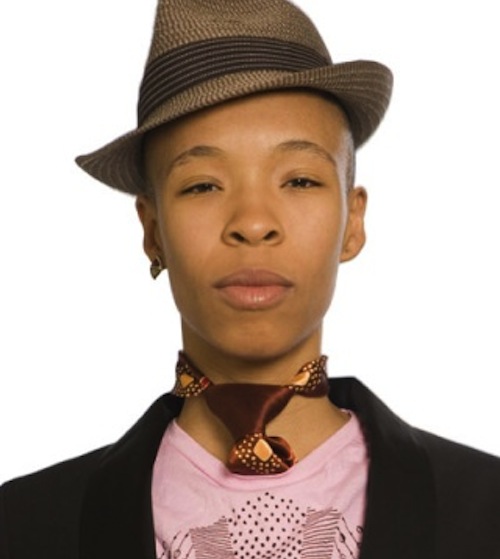
Hanifah Walidah: When we think of blues we think of form and lyrics. With blues specifically, it’s often hard to imagine one without the other. But the blues form and performance is the root to most forms of American music. The historical (here I go again) conditions in which blues came to be and jazz for that matter is only temporally different from the rise of hip hop. Again, I am resistant to split, splice and dice music expressions into bite size differences. We all know it is a continuum of African cultural experience in this country. Black folk music is synonymous with the context in which we live. Our culture mirrors our intellectual and spiritual connection to our surroundings and healing which is often a form of freestyle only in that we may be reacting to what we often cannot control (considering our history). That is its beauty and its magic. The theory behind hip hop poetics may be good for intellectual conversation and building institutional infrastructure, but for the performer, and I will speak for myself, the growth and expansion of a musical art form happens when you are creating it, not prefacing it with theory. It happens in freestyle when YOU aren’t always the only one spitting at any given moment. When there are spirits and history visible and not orchestrating things to push the gift of music beyond our intellectual ego. And I hope this is received not to criticize hip-hop scholarship, which does have a place in cultural discourse, of course, but to answer your question, Hip Hop Poetics relates to the blues and jazz in the same way I relate to my mother and her mother. We are a continuum of the same song in freestyle mode.
Douglas Kearney: Fred Moten has this idea that performance is study. He applies this to Curtis Mayfield singing live: Mayfield in that act of song is a student of soul.
Hip-hop is not just a thing on a page but there is a part of it that can exist there (the “hip hop quotable”; the black book; the photograph; the documentation that is a cassette). The performance of it is the significant part. I’m ranging here. And I hear you, Hanifah. Perhaps I get edgy about the equation between “theory” and “academic” in the same way you respond to dicing up musics. I just don’t think theory means it’s in a book that the people can’t touch. I think black folks have mad theory before they touch a mic. That theory tells us that touching a mic may be necessary in the first place. I think Blues sprung from a context and an aesthetic history, not a DNA. That doesn’t make it less powerful for me.
I also think there is a difference between performing on one’s stoop and performing on a stage, singing blues on a porch and singing blues at a concert. If we don’t acknowledge that, I think we are fooling ourselves to (a) our participation in community and (b) our compliance with the notion that the stage is a space with different access (for audience and performers) than another context, and that being there is a different kind of exchange (pun intended).
Also, don’t you think “only temporally different” is an elephant pretending it’s a mouse? Especially when discussing the relationship between black culture and black agency (control) over the course of the 19th to 21st centuries?
Hanifah Walidah: I’m not sure where you are applying agency DK. I think the creative agency is the same because segregation, oppression and lack of ownership of physical spaces were the elephants in the room for the development of both musics. The Bronx was alienated, isolated and gutted which supported desperation for expression or simple release. Even regarding business, the women who developed classic blues or was at the forefront of the emerging music industry saw the value in their performance. Ma Rainey didn’t own a record label but she ran her own vaudeville shows that were the first to choreograph and present blues (black music) as a consumable product on stage and record. Interestingly enough, when Sylvia Robinson went around trying to record the big rappers at the time (late 70s) they wasn’t hearing her. They couldn’t imagine recording what they essentially saw as a never-ending performance. I don’t think black folks have now or recently anymore agency then they did back in the early days of the music industry. Same agencies. Same pitfalls.
http://www.youtube.com/watch?v=AzsIk8z26tg
And so we end Part 1 of DWYCK : a Cypher on Hip Hop poetics. Check in Friday for Part 2 peoples. It ain't over. Party's not over.
_____________________________________________________________
Kyle Austin aka High Priest aka HPrizm: Composer, Lyricist, Educator—Founding member of the rap collective Antipop Consortium. Priest’s latest composition, a tone-poem/tribute to Thelonious Monk and Bud Powell entitled “WAVES” is slated to premiere at Sons d’hiver in Paris featuring David Viralles, Steve Lehman and Wadada Leo Smith. His collection of written works, Back to Kush will be published by Glassman & Bear in 2014.
Douglas Kearney aka Magellan aka Blot: Poet/performer/librettist whose second, full-length collection of poetry, The Black Automaton (Fence Books, 2009), was Catherine Wagner’s selection for the National Poetry Series. Red Hen Press will publish Kearney’s third collection, Patter, in 2014. Raised in Altadena, CA, he lives with his family in California's Santa Clarita Valley. He teaches at CalArts.
Patrick Rosal aka P-Ski of the Majestic Force Breaking Crew: the author of three full-length poetry collections of them include Boneshepherds. A former Fulbright Fellow, he is currently on the faculty of Rutgers University- Camden's MFA program, where he teaches poetry, poetics, and remix history and culture.
Hanifah Walidah aka Sha-key: musician, playwright, educator and ethnographer. She is the co-founder of the poet/performance collectives The Vibe Khamelons and The Boom Poetic, both recognized as groundbreaking for their fusion of hip hop lyric structure, beatnik cadence and poetry. A longtime member of the neofunk band Brooklyn Funk Essentials, Hanifah currently lives in Paris and is touring with her band, St. Lo.
Poet, educator, and musician, Yolanda Wisher aka Little Nay, Nay Nay and Pootsie, hails from Philadelphia, PA where she directs a youth education program for the Mural Arts Program. The founder of Poetry for the People Philly and the Germantown Poetry Festival, her first book of poetry will be published by Hanging Loose Press in 2014.
LaTasha N. Nevada Diggs aka Squeaky representing Harlem, USA. Die hard Depeche Mode fan. Does not know how to manipulate her gluteal muscles to a beat. Once had a phone thang with the road manager for Funkdoobiest. Occupational hazard.
Tarot of the Day: The Hierophant, The Devil, The Hermit
Song for the Day: Lauryn Hill "Lost Ones"
Interdisciplinary poet and sound artist LaTasha N. Nevada Diggs was born and raised in Harlem. She studied...
Read Full Biography

